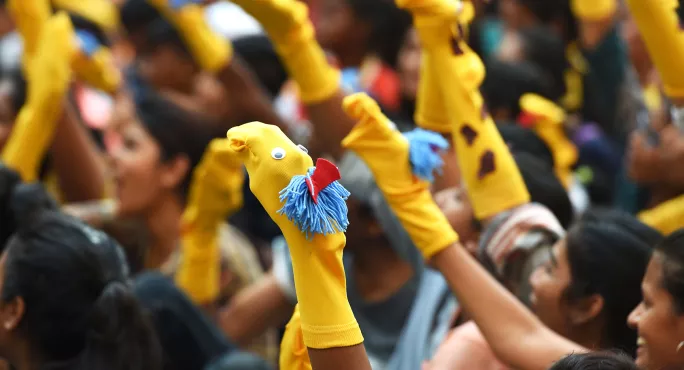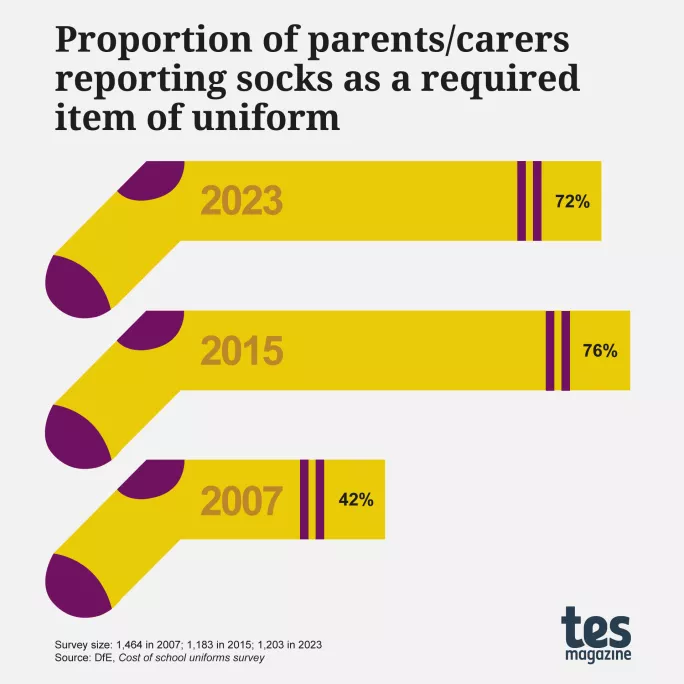How socks became part of the school uniform couture war

Debates about school uniform requirements and the issues they put on parents regularly make headlines - most frequently due to the perceived cost pressures they create.
Labour even saw the issue as a potential vote winner with its manifesto promising to tackle the rising costs caused by items such as blazers, jumpers and ties that schools frequently require parents to buy.
But a new report commissioned by the Department for Education and published last week reveals another clothing item that has, quietly, become part of the couture wars: the humble sock.
Specifically, the report shows that, in 2007, a survey of over 1,400 parents found just 42 per cent said the school their children attended had specific sock requirements. And, by 2015, this had risen to 76 per cent.
It did drop slightly in the most recent survey, to 72 per cent in 2023 - but that’s still up significantly from 15 years before and suggests socks are now an established part of uniforms.

Perhaps surprisingly, while this growth has been seen across the sector, it is primary schools where it has become more common - with 74 per cent of primary parent/carer respondents citing this requirement in 2023, compared to 70 per cent for secondary schools.
Within these schools, the number requiring branded socks was much lower, with just 8 per cent of respondents saying this is a requirement.
While in the minority, this certainly goes against the latest DfE advice which specifically cites socks as an area where branding is perhaps a step too far.
“Whilst it may be appropriate to require a certain colour for socks, requiring them to have the school logo would be unnecessary,” it says.
As this guidance notes though, specifying colours is fine and is no doubt going to be at the heart of most policies.
All this means, as per the report, that parents are now buying an average of nine pairs of socks at around £2.40 a pair, for a total of around £20. This equates to 8 per cent of the total average spend of £250 the research cites as most parents’ spending (excluding PE kit).
Sock it to ‘em
So why has this happened?
Keziah Featherstone, co-chair of the Headteachers’ Roundtable, says members of the group report seeing numerous different reasons for sock policies - including one quite serious one.
“Different coloured socks have been used in some schools to show gang allegiances,” she says.
More broadly, she says that because socks had remained under the radar for so long, more fashion-conscious students used it as a way to show off certain brands: “At a time when schools had managed to remove all other visible signs, socks can be a bit sneaky.”
To show them off though, you of course have to make them quite evident - which no doubt led many headteachers to clamp down and put rules in place, Featherstone notes.
Meanwhile, Tom Bennett - who has acted as government behaviour advisor since 2015 - says he believes the increase in sock-specific rules has coincided with schools recognising the need for consistent uniform rules that cover all items worn.
“Minor items, like socks are - by themselves - only as important as you choose them to be. But as with any other uniform rule, if the school decides to have it, it should commit to it,” he says.
“Details matter […] Allowing students not to follow this, when you have committed publicly to it, signals a lack of sincerity in one’s own decisions.”
One leader of a primary trust says this is very much their view when it comes to socks being part of uniform requirements.
“It supports our overall vision for uniform,” they say. “We want our pupils to look smart, be proud to be a member of the trust and their school and for all children to feel a sense of community and belonging.”
As such they have requirements like ‘Grey socks / grey tights / white socks’ in one school and ‘Grey or white socks and grey tights’ in another.
They add they think this is “light touch and accessible” and have “never found this to be a barrier with parents”.
Another leader who backs the rise in sock policies echoes Bennett’s point that it reveals the true colours of a school’s ethos.
“It’s not about socks, it’s about standards, details, upholding policies that are fit for purpose - great school leaders have attention to detail and this transfers to policies,” they say.
“If you have a specific colour sock in your policy you need to uphold it otherwise how do your community know which other parts of which other policies you’re not bothered about let’s say in your health and safety policy or your staff code of conduct just as two examples.”
Pull your socks up
Others though are less convinced this is a useful development. For example, Turner Schools CEO Seamus Murphy says they have no policies on socks and laments that so many other schools have moved in this direction.
“Over the last 15 years there has been a fundamental disconnect between the dominant educational establishment of traditionalists and the lived experience of children and their parents,” he says.
“Nothing speaks more to this than the fact that over 70 per cent of schools continue to fixate on uniform rules, including what socks are acceptable, at a time when incomes have risen by 0.84 per cent, child poverty has risen by 44 per cent and attendance has fallen through the floor.”
A classroom teacher who has witnessed schools moving to police socks, agrees - noting the irony with which many schools claim to “develop individuality and independence” in their learners, but then create endless means of control.
“Controlling who wears what socks doesn’t affect outcomes or shape futures but it might make some school leaders - increasingly beleaguered by daft policies - feel as if they’re making an impact, even if it ends at the ankles,” they add.
Jason Elsom, CEO of Parentkind, adds that while the cost of socks may be small compared to some items, the reality is that, for many parents, uniform costs are excessive and specific sock requirements represent another outlay they could do without.
“Adding little extras to the cost of school just makes life harder for parents at a time when they are under severe strain,” he says. “We need schools to listen to parents and do what they can to reduce the financial burden on them.”
This is no doubt the thinking within Labour when it promised to look at school uniform costs - something Murphy at Turner Schools says is a move that should be welcomed.
“Thankfully Labour look set to call time on this nonsense, with a focus on reducing the number of branded items, in recognition of the acute financial pressure that families are under,” he says. “It’s high time the focus was on pupil productivity, not on pupil uniformity.”
Whether that means schools relax their sock requirements though remains to be seen.

Keep reading for just £1 per month
You've reached your limit of free articles this month. Subscribe for £1 per month for three months and get:
- Unlimited access to all Tes magazine content
- Exclusive subscriber-only stories
- Award-winning email newsletters



